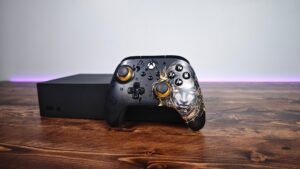Nielsen Sees Rise in the appeal of Virtual Reality In The US amongst gamers.
Nielsen, a consumer trends analyst site has put out new information regarding the appeal of Virtual Reality amongst American gamers. VR has already offered consumers everything from full 360 videos, that have the power to transport the user to exotic and daring places in virtual tourism to fast paced action shooters and survival horror games. Nelsen notes the success of Resident Evil 7: Biohazard, one the bigger more AAA titles to come out and embrace the world of VR, proving that VR experiences can be more immersive and provide the user with full-fledged gaming experiences.
VR and AR adoption rates are still relatively low, however, the awareness of them have almost doubled from a year to year basis. Rising from a meagre 28% of the general U.S population in 2016, all the way to 51%. This rise sets even more of a precedent due to the fact that barrier posed by accessibility and awareness that some of the more premium VR and AR devices have. Google currently leads in offering the most affordable VR experience, with their Google Cardboard, however, only 19% of Americans are even aware of Google’s device.
There is an interesting skew in awareness of the various VR and AR devices that are currently available, with gamers generally being much more aware of their presence in the market. Samsung is at the helm with 34% awareness for the general public, above the age of 13, and for gamers in the same age bracket; Samsung is even higher with awareness at 43%. Sony’s PlayStation VR sits at a 26% awareness level for the general populace, just ahead of the Oculus Rift, which sits at 25%. For gamers, both the PSVR headset and Oculus Rift are tied at 33%. As mentioned earlier the Google Cardboard is at 19% and for gamers, that percentage sits a little higher, at 25%. The HTC, which many consider to the best way to experience VR, is at 10% awareness by the average American and for gamers, that number is 15%.
Microsoft’s own offering, the HoloLens is currently at only a 10% awareness rate for Americans and 13% for gamers. Finally, The RazerOSVR is at a paltry 5% awareness rate, with gamers just slightly ahead at 7%.
When asked how likely an individual was to purchase a VR/AR headset, the general population tended to gravitate towards Samsung’s offering, which garnered a 7% response, as for gamers, they tended to want a console VR device, opposed to a mobile or even a computer headset, with Sony’s PSVR leading with 10%. When asked if consumers actually intend to purchase a headset of any kind, men seemed to be significantly higher, with a 69% response rate that said yes, whereas women were been reluctant wat 31%. For a more detailed and graphical breakdown of VR and AR trends, readers can visit the Neilsen site.




